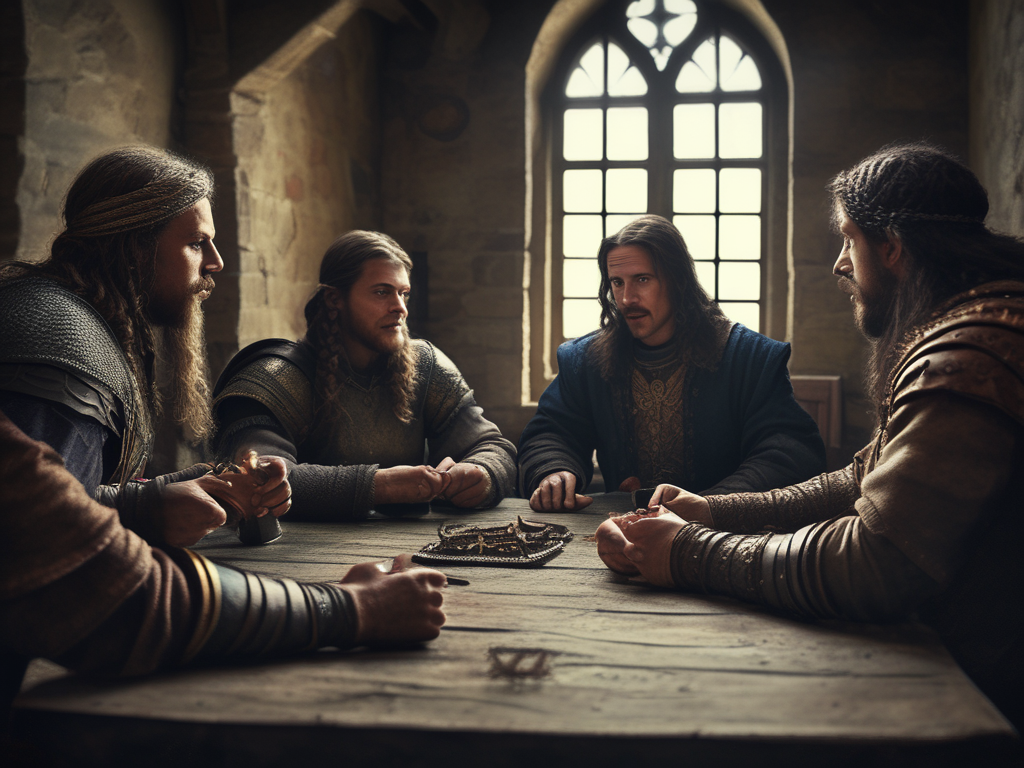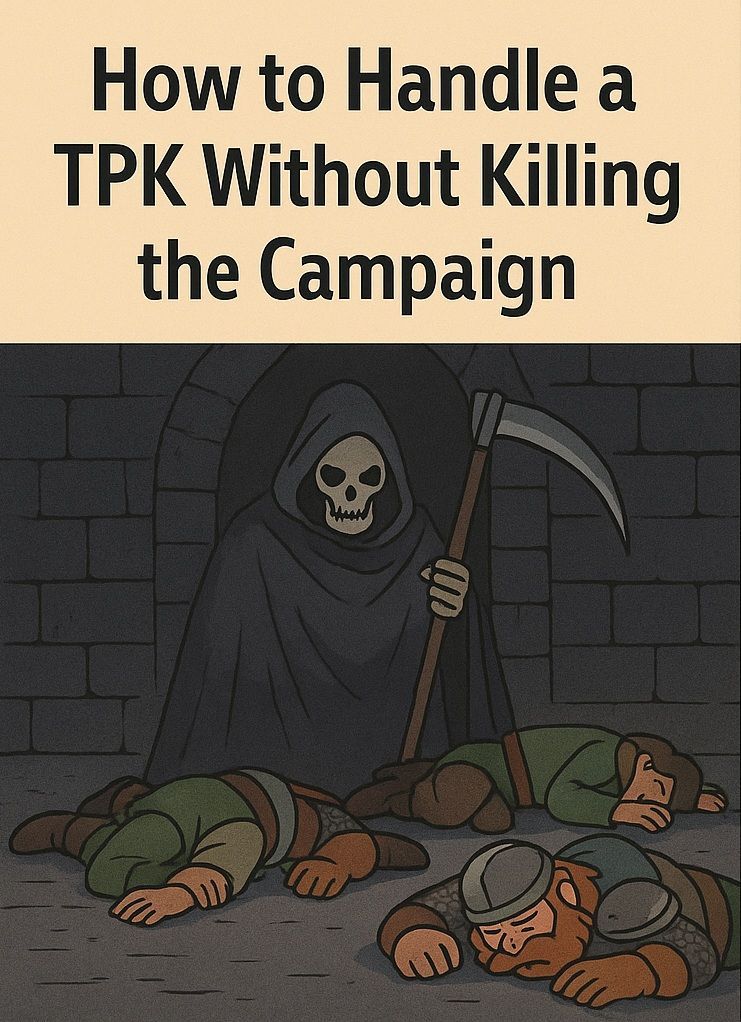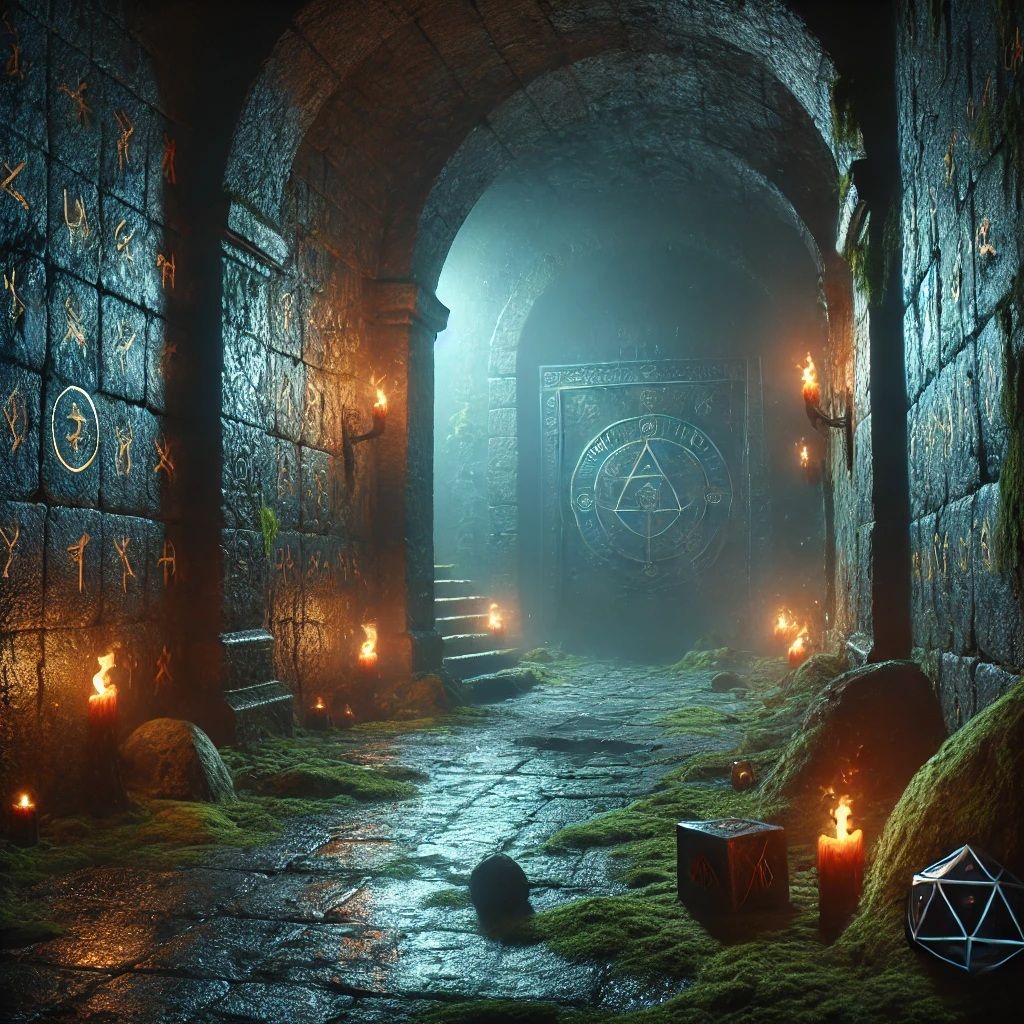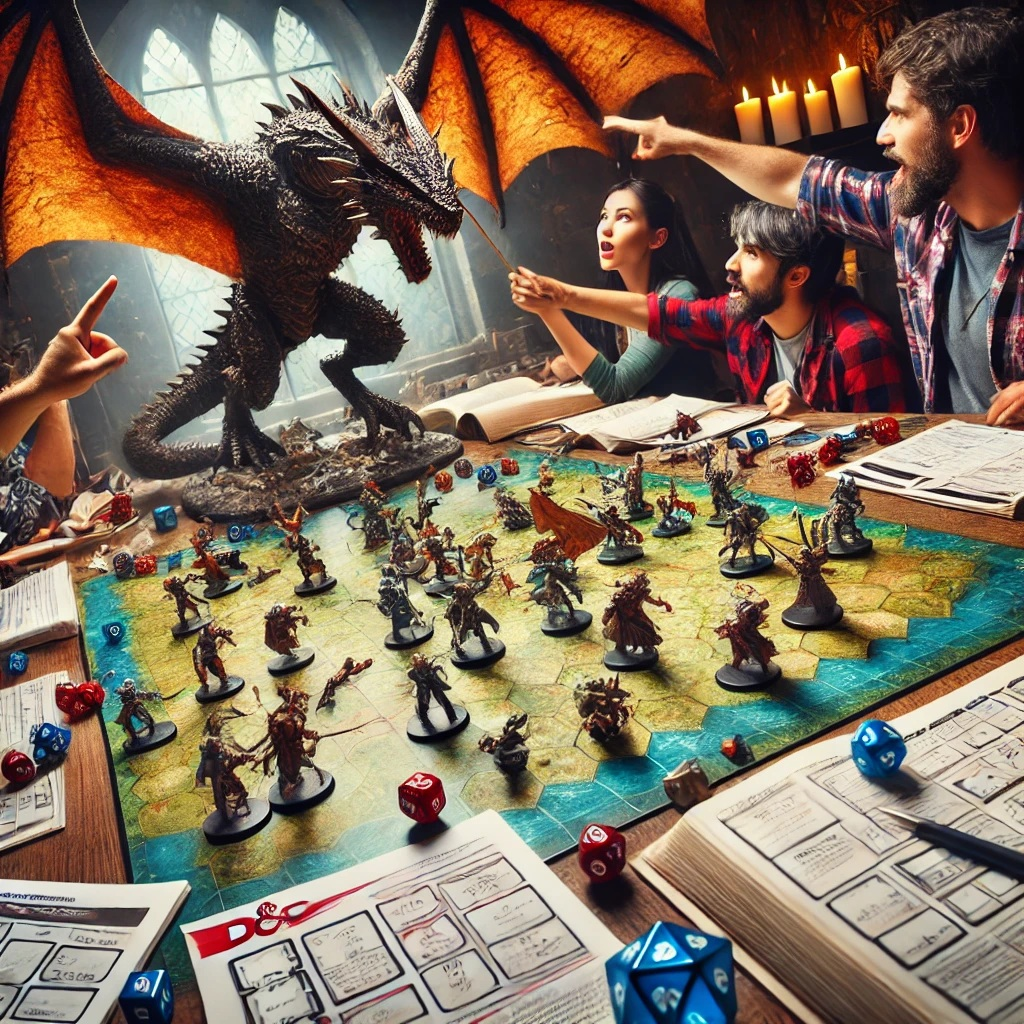Building Rivalries: Creating and Managing Intra-Party Conflicts

Dear Readers, welcome back to our Dungeons & Dragons (D&D) blog! Today, we’re delving into the nuanced and often thrilling aspect of intra-party conflicts and rivalries. While D&D is a cooperative game, introducing well-crafted rivalries and conflicts can add depth to the story, foster character development, and create memorable moments. However, managing these elements requires careful balance to ensure they enhance rather than detract from the overall experience. In this post, we’ll explore strategies for creating and managing intra-party conflicts, discuss the benefits and potential pitfalls, and provide practical examples to inspire your campaigns. So, let’s embark on this journey to master the art of building rivalries and managing intra-party conflicts.
The Benefits of Intra-Party Conflicts
Intra-party conflicts can bring numerous benefits to your campaign, enriching the narrative and deepening character development. Here are some key advantages:
1. Enhanced Character Development
Conflicts and rivalries can reveal different facets of a character’s personality, motivations, and backstory. These interactions provide opportunities for growth and depth.
Example: A rivalry between a paladin and a rogue can highlight the paladin’s unwavering sense of justice and the rogue’s pragmatic approach to survival, leading to mutual understanding and respect over time.
2. Engaging Storylines
Conflicts can drive engaging storylines and subplots, adding layers of intrigue and drama to the main campaign. They keep players invested in the narrative and eager to see how their relationships evolve.
Example: A wizard’s pursuit of forbidden knowledge puts them at odds with the cleric’s religious convictions, creating a subplot that explores themes of morality and power.
3. Dynamic Interactions
Intra-party conflicts can lead to dynamic and memorable interactions, both in and out of combat. These moments can become defining parts of your campaign’s history.
Example: A heated argument between two characters during a critical moment in battle can lead to an intense and unforgettable role-playing scene.
Strategies for Creating Intra-Party Conflicts
Creating intra-party conflicts requires thoughtful planning and a focus on character-driven storytelling. Here are some strategies to help you create meaningful and engaging conflicts:
1. Establish Clear Motivations
Conflicts should arise from clear and understandable motivations. Each character involved should have a reason for their actions and beliefs, rooted in their backstory and personality.
Example: A ranger who values nature above all else may clash with a wizard who sees natural resources as tools for their magical experiments. Both have clear motivations: the ranger’s dedication to preserving nature and the wizard’s pursuit of knowledge.
2. Encourage Backstory Integration
Integrate character backstories into the conflict. This personal connection makes the conflict more meaningful and relevant to the characters involved.
Example: A warrior with a tragic past involving bandits may have a deep-seated mistrust of the rogue, who has a history of petty crime. This backstory integration adds layers to their interactions.
3. Focus on Ideological Differences
Ideological differences can be a rich source of conflict. Characters with opposing worldviews or values can naturally come into conflict as they navigate the challenges of the campaign.
Example: A lawful good paladin and a chaotic neutral bard may have fundamentally different approaches to achieving their goals, leading to frequent disagreements and debates.
4. Use NPCs and External Factors
Introduce NPCs or external factors that exacerbate existing tensions or create new conflicts. This can add complexity and depth to the rivalries.
Example: A charismatic NPC who manipulates the party’s cleric into questioning the sorcerer’s motives can create tension and distrust within the group.
5. Allow Conflicts to Evolve
Allow conflicts to evolve naturally over time. Characters should have opportunities to resolve or escalate their conflicts based on their actions and decisions.
Example: An initial rivalry between two characters can evolve into a deep friendship or a bitter enmity, depending on how they interact and grow throughout the campaign.
Managing Intra-Party Conflicts
While intra-party conflicts can enrich your campaign, they must be managed carefully to prevent them from becoming disruptive or harmful. Here are some strategies for managing conflicts effectively:
1. Set Boundaries and Expectations
Set clear boundaries and expectations for conflicts at the start of your campaign. Discuss with your players the importance of keeping conflicts in-character and avoiding personal issues.
Example: During your session zero, establish a rule that all conflicts must remain in-character and that any out-of-character issues should be addressed immediately and respectfully.
2. Facilitate Open Communication
Encourage open communication among your players. Regularly check in with them to ensure that everyone is comfortable with the direction of the conflicts and that no one feels targeted or marginalized.
Example: Periodically ask your players for feedback on how the conflicts are affecting their enjoyment of the game and make adjustments as needed.
3. Use Conflicts as Opportunities for Growth
Frame conflicts as opportunities for character growth and development. Encourage players to explore how their characters can learn and evolve through their interactions with each other.
Example: After a major conflict, prompt the involved characters to reflect on their actions and consider how they can grow from the experience, potentially leading to resolution or deeper understanding.
4. Balance Conflict and Cooperation
Ensure that conflicts are balanced with moments of cooperation and camaraderie. The party should still function as a team and work towards common goals, despite their differences.
Example: Incorporate scenarios that require the party to work together and leverage each other’s strengths, reinforcing the importance of unity even amidst conflict.
5. Know When to Intervene
As the DM, be prepared to intervene if conflicts become too intense or disruptive. Your primary responsibility is to ensure that all players are having fun and that the game remains enjoyable for everyone.
Example: If a conflict is escalating beyond a manageable level, call for a break and address the issue with the involved players privately, working towards a resolution that keeps the game on track.
Practical Examples of Intra-Party Conflicts
To illustrate how you can apply these strategies, here are practical examples of intra-party conflicts and rivalries, along with tips for managing them:
Example 1: The Paladin and the Rogue
Conflict: Sir Cedric, a lawful good paladin, and Lyra, a chaotic neutral rogue, often clash over their differing approaches to problem-solving. Cedric insists on following the law and acting with honor, while Lyra prefers a more pragmatic and sometimes underhanded approach.
Creation Strategies:
- Clear Motivations: Cedric’s unwavering dedication to justice and Lyra’s survival instincts and disdain for authority create a natural source of conflict.
- Backstory Integration: Cedric’s backstory involves a strict code of honor instilled by his order, while Lyra grew up on the streets, learning to fend for herself by any means necessary.
- Ideological Differences: Their fundamentally different worldviews lead to frequent disagreements on how to handle various situations.
Management Strategies:
- Set Boundaries: Establish that all conflicts should remain in-character and that both players should respect each other’s perspectives.
- Facilitate Communication: Check in with the players to ensure they are comfortable with the conflict and that it remains a positive aspect of the game.
- Balance Conflict and Cooperation: Include scenarios where Cedric’s honor and Lyra’s cunning both play crucial roles in achieving success, highlighting the value of their differing approaches.
Outcome: Cedric and Lyra’s rivalry evolves into a mutual respect as they learn to appreciate each other’s strengths. Their dynamic adds depth to the campaign, and both characters grow from their interactions.
Example 2: The Wizard and the Cleric
Conflict: Thalia, a wizard obsessed with uncovering forbidden knowledge, frequently butts heads with Brother Marcus, a cleric devoted to preserving sacred traditions and opposing dark magic.
Creation Strategies:
- Clear Motivations: Thalia’s thirst for knowledge and power contrasts with Marcus’s commitment to upholding the tenets of his faith.
- Backstory Integration: Thalia’s mentor was exiled for delving into forbidden magic, fueling her determination to continue his work. Marcus’s backstory involves witnessing the destructive potential of dark magic, reinforcing his aversion to it.
- Ideological Differences: Their opposing views on the use of magic create a persistent source of tension.
Management Strategies:
- Set Boundaries: Ensure both players agree to keep their conflict in-character and to avoid personalizing the disagreements.
- Use NPCs and External Factors: Introduce NPCs who challenge Thalia’s and Marcus’s beliefs, forcing them to confront their own convictions and reconsider their stances.
- Encourage Growth: Prompt both characters to reflect on their beliefs and consider how their interactions can lead to personal growth and understanding.
Outcome: Through their conflicts, Thalia and Marcus develop a deeper understanding of each other’s perspectives. Thalia learns to appreciate the ethical implications of her studies, while Marcus becomes more open to the pursuit of knowledge, provided it is used responsibly.
Example 3: The Ranger and the Druid
Conflict: Arin, a ranger dedicated to protecting nature, and Elowen, a druid who believes in the balance of all things, clash over their differing philosophies on how to interact with the natural world.
Creation Strategies:
- Clear Motivations: Arin’s mission to defend the wilderness at all costs contrasts with Elowen’s belief in natural cycles and the inevitability of change.
- Backstory Integration: Arin’s home forest was destroyed by logging, fueling his desire to protect nature aggressively. Elowen’s upbringing in a druidic circle taught her the importance of balance and harmony.
- Ideological Differences: Their differing approaches to environmental issues create a recurring source of conflict.
Management Strategies:
- Set Boundaries: Emphasize the importance of keeping their conflict in-character and maintaining respect for each other’s viewpoints.
- Balance Conflict and Cooperation: Design encounters that require both Arin’s protective instincts and Elowen’s knowledge of natural cycles, demonstrating the value of their differing philosophies.
- Facilitate Communication: Encourage in-character discussions where Arin and Elowen can express their beliefs and seek common ground.
Outcome: Arin and Elowen’s rivalry leads to a stronger partnership as they learn to combine their strengths. Arin’s vigilance and Elowen’s wisdom complement each other, enhancing their ability to protect and understand the natural world.
Tips for Encouraging Healthy Intra-Party Conflicts
To ensure that intra-party conflicts remain a positive and enriching aspect of your campaign, consider the following tips:
1. Foster a Collaborative Environment
Encourage a collaborative environment where players feel comfortable expressing their ideas and concerns. This openness fosters mutual respect and understanding, even during conflicts.
Example: Hold regular group discussions where players can share their thoughts on the campaign, their characters, and any conflicts, ensuring that everyone’s voice is heard.
2. Focus on Character-Driven Conflicts
Ensure that conflicts arise naturally from character motivations and backstories rather than forced or contrived situations. Authentic, character-driven conflicts are more engaging and meaningful.
Example: If a character’s backstory includes a rivalry with a specific type of NPC, introduce a scenario that brings this rivalry to the forefront, creating organic conflict.
3. Maintain a Balance
Balance conflicts with moments of cooperation and camaraderie. The party should still function as a team, working together to achieve common goals despite their differences.
Example: Design encounters and challenges that require the party to leverage each other’s strengths, reinforcing the importance of teamwork.
4. Encourage Respectful Role-Playing
Encourage players to approach conflicts with respect for each other’s characters and perspectives. Remind them that the goal is to enhance the story, not to “win” the conflict.
Example: Discuss the importance of respectful role-playing during session zero and periodically remind players to focus on character development rather than personal victory.
5. Use Conflict Resolution Techniques
Introduce conflict resolution techniques within the game to help characters navigate and resolve their differences. This can include mediation by NPCs, in-character discussions, or structured resolutions.
Example: An NPC mentor or leader can mediate a conflict between characters, guiding them towards a resolution that acknowledges both perspectives.
Example of a Campaign with Intra-Party Conflicts
To illustrate how you can implement and manage intra-party conflicts, here’s an example of a campaign with multiple conflicts and rivalries:
Campaign: Shadows of Arcanum
Setting: The city of Arcanum, a sprawling metropolis where magic and technology coexist. The city is a hub of innovation and power, but also a hotbed of political intrigue and hidden dangers.
Characters:
- Cedric, the Paladin: A member of the Order of the Silver Flame, dedicated to upholding justice and rooting out corruption.
- Lyra, the Rogue: A street-smart thief with a knack for finding valuable information and a disdain for authority.
- Thalia, the Wizard: A scholar obsessed with uncovering ancient and forbidden knowledge, often at the expense of ethical considerations.
- Brother Marcus, the Cleric: A devout follower of the Lightbringer, committed to preserving sacred traditions and opposing dark magic.
- Arin, the Ranger: A protector of the wilderness who believes in defending nature against all threats.
- Elowen, the Druid: A practitioner of druidic magic who believes in the balance of all things and the inevitability of natural cycles.
Plot Overview: The party is brought together by a shared mission to investigate a series of mysterious events in Arcanum. They uncover a plot by a powerful cabal to harness forbidden magic and seize control of the city.
Intra-Party Conflicts:
- Cedric and Lyra:
- Conflict: Cedric’s commitment to justice and Lyra’s pragmatic approach lead to frequent clashes over how to handle situations involving the law and authority.
- Evolution: Through their interactions, Cedric learns to appreciate Lyra’s resourcefulness, while Lyra gains respect for Cedric’s unwavering principles.
- Thalia and Marcus:
- Conflict: Thalia’s pursuit of forbidden knowledge puts her at odds with Marcus’s dedication to preserving sacred traditions and opposing dark magic.
- Evolution: As the campaign progresses, Thalia begins to understand the ethical implications of her studies, while Marcus becomes more open to the pursuit of knowledge, provided it is used responsibly.
- Arin and Elowen:
- Conflict: Arin’s aggressive approach to protecting nature conflicts with Elowen’s belief in balance and harmony, leading to disagreements on how to interact with the natural world.
- Evolution: Through their experiences, Arin and Elowen develop a mutual respect, learning to combine their strengths to protect and understand the natural world.
Managing the Conflicts:
- Set Boundaries: Establish that all conflicts should remain in-character and discuss the importance of respectful role-playing during session zero.
- Facilitate Communication: Regularly check in with players to ensure they are comfortable with the direction of the conflicts and make adjustments as needed.
- Balance Conflict and Cooperation: Design encounters that require the party to work together, reinforcing the importance of unity even amidst conflict.
- Use NPCs and External Factors: Introduce NPCs and external factors that challenge the characters’ beliefs and force them to confront their own convictions.
- Encourage Growth: Prompt characters to reflect on their actions and consider how their interactions can lead to personal growth and understanding.
Conclusion
Building and managing intra-party conflicts can add depth, drama, and excitement to your D&D campaign. By creating conflicts that arise naturally from character motivations and backstories, setting clear boundaries and expectations, and fostering a collaborative environment, you can ensure that these conflicts enhance rather than detract from the overall experience.
Remember to balance conflicts with moments of cooperation, encourage respectful role-playing, and use conflict resolution techniques to guide characters towards growth and understanding. Whether you’re exploring ideological differences, personal rivalries, or moral dilemmas, well-crafted intra-party conflicts can create memorable moments and enrich your campaign.
Until next time, Dear Readers…






















